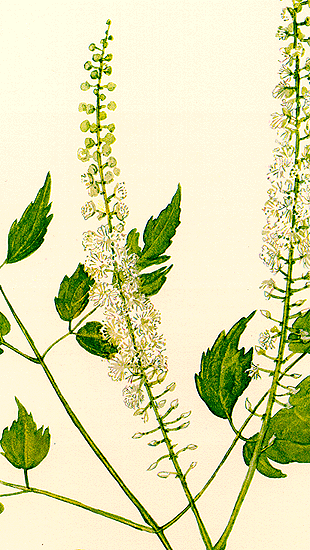The Point: Black Snakeroot

CAPTION: Black Snakeroot,
Cimicifuga racemosa (Linnaeus) Nuttall.
This is a leafy, perennial, midsummer wild flower of the buttercup
family, which grows from three to eight feet tall. It is found in
woodland openings and rocky thickets. The branded flower-cluster is
made up of several long, slender, white, erect racemes, which stand
out conspicuously against the dark woodland background. The flowers
are very numerous, blooming successively from the base of the raceme
upwards, and consist mostly of white stamens: the petals are minute
and the sepals fall when the bud opens. The flowers have only one or
two carpels each. The black, knotted, rootstocks have been much
collected for medicinal purposes; in pioneer times they were used to
treat snakebite.
A similar European species has a strong odor and has been used to
drive away vermin, hence the genus name Cimicifuga: from
cimex, bug; and fugere, to drive away.
The plant shown in the painting was collected by L. K. Henry on a
wooded slope at Zelienople, Butler County, Pennsylvania, August 2,
1941.
NOTES: From Wild Flowers of Western Pennsylvania
and the Upper Ohio Basin, Text by O. E. Jennings; Watercolors by
Andrey Avinoff, Volume Two. Pittsburgh: Carnegie Institute and University
of Pittsburgh, 1953.
PHOTOGRAPHER:
DATE:
HEADING:
#:
From the Collections of the Pennsylvania Department,
The Carnegie Library of Pittsburgh.
 mages 5.
mages 5.
 arrative.
arrative.
 utline.
utline.
 eighborhoods.
eighborhoods.
 ain Menu.
ain Menu.

